Abstract
The influence of multiple doses of ciprofloxacin on the disposition of caffeine and its major metabolite, paraxanthine, was investigated in healthy volunteers. Ten xanthine-free, fasting males were given 100 mg of caffeine orally 24 h before being given ciprofloxacin and again with the third dose of ciprofloxacin (750 mg administered every 12 h). Blood samples were serially collected after both doses of caffeine and after the first and last doses of ciprofloxacin. Ciprofloxacin significantly increased the half-life of caffeine (from 5.2 +/- 1.2 to 8.2 +/- 2.5 h) and the area under the caffeine concentration-time curve (from 16.3 +/- 6.6 to 25.9 +/- 7.8 micrograms.h/ml) while decreasing the total body clearance (from 106 +/- 41.6 to 58.2 +/- 28.8 ml/min per 1.73 m2). In addition, the rate of conversion of caffeine to paraxanthine was significantly delayed. There was no significant linear correlation between the urinary recovery of oxociprofloxacin at 0 to 12 h and the change in the area under the caffeine concentration-time curve. There was also a small but statistically significant increase in the area under the ciprofloxacin concentration-time curve during simultaneous administration of caffeine. We concluded that ciprofloxacin causes a significant increase in the half-life of caffeine and in the area under the caffeine concentration-time curve by reducing total body clearance. This interaction is due at least in part to a delay in the conversion of caffeine to paraxanthine. The clinical significance of these observations remains to be determined. Lastly, caffeine may alter the kinetics of ciprofloxacin, a possibility which should be more fully explored.
Full text
PDF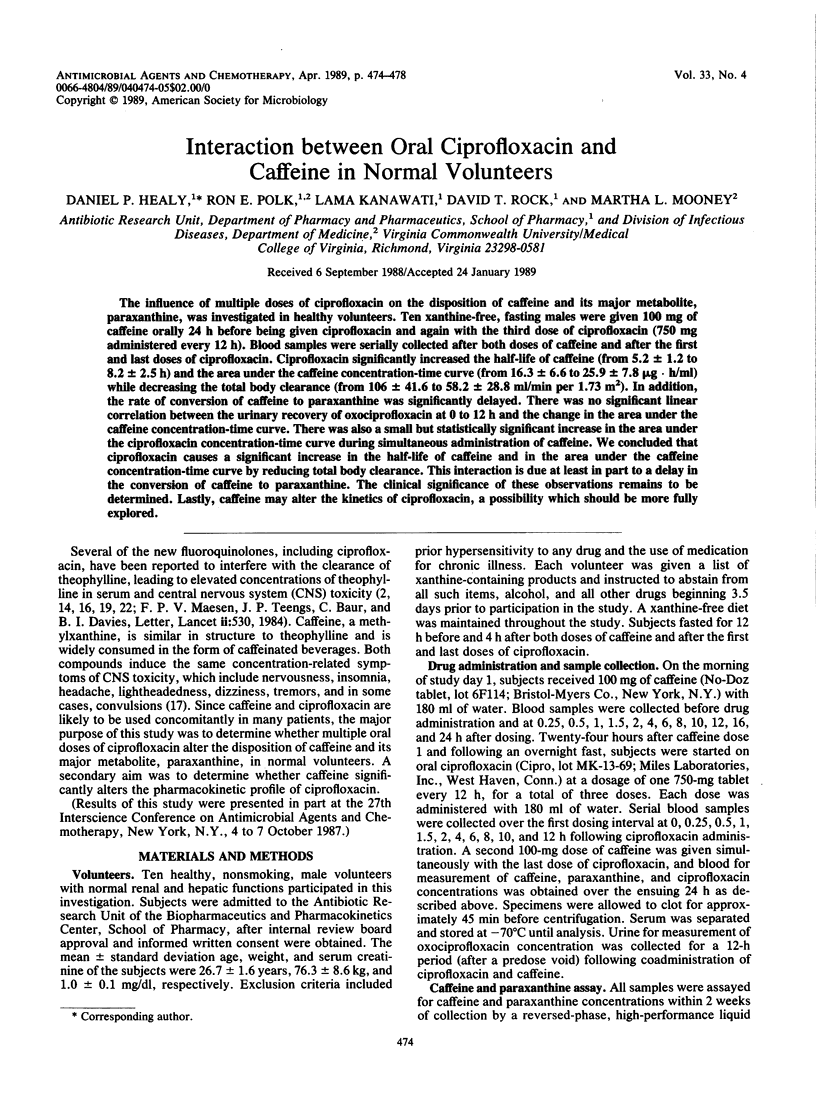
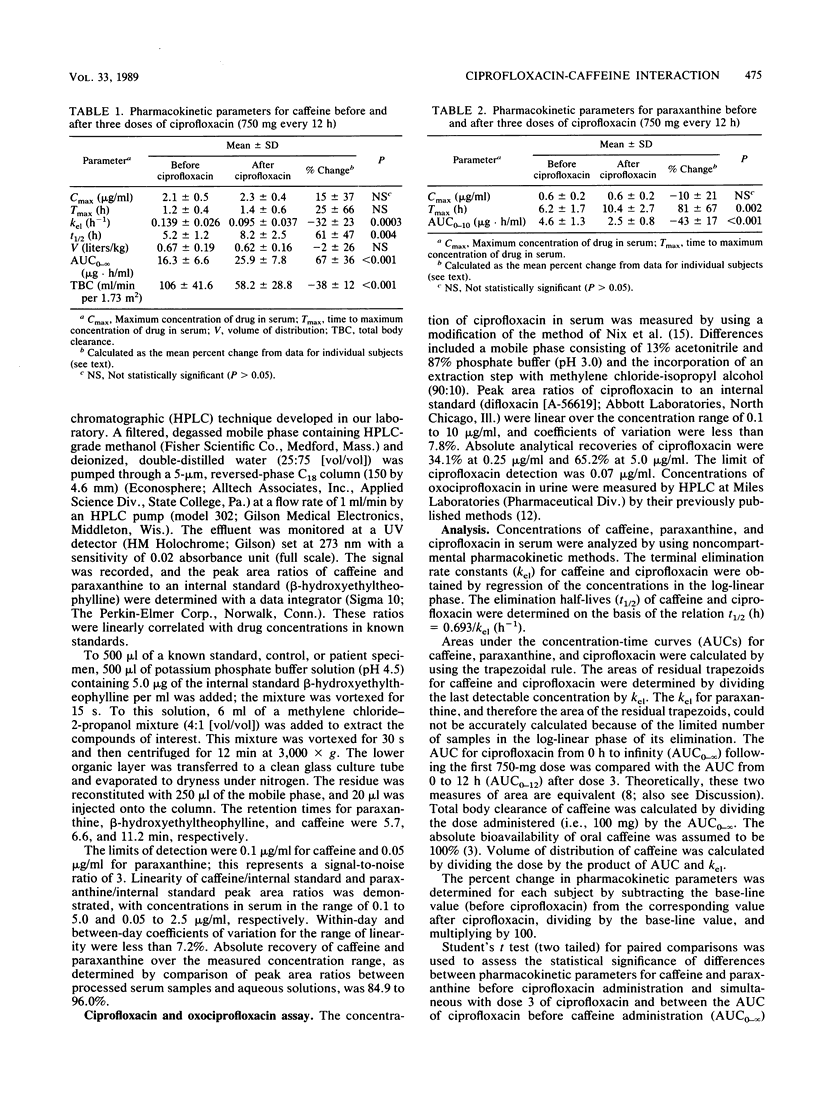
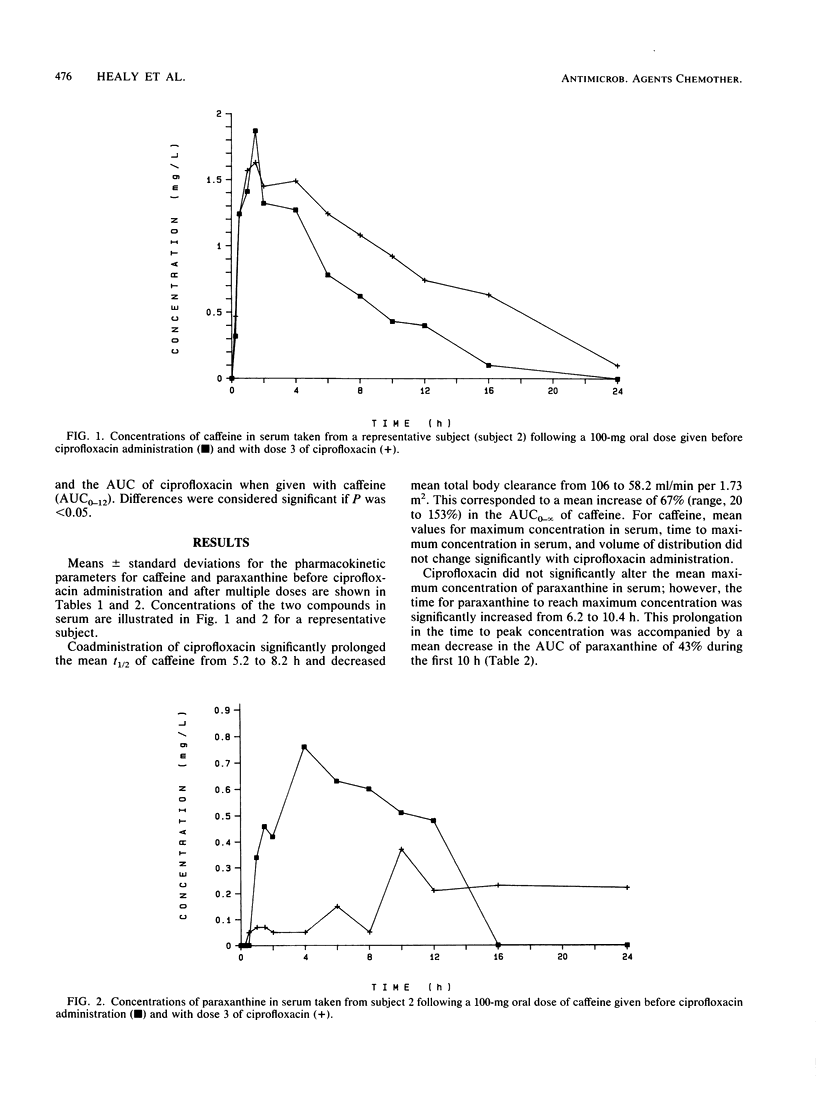
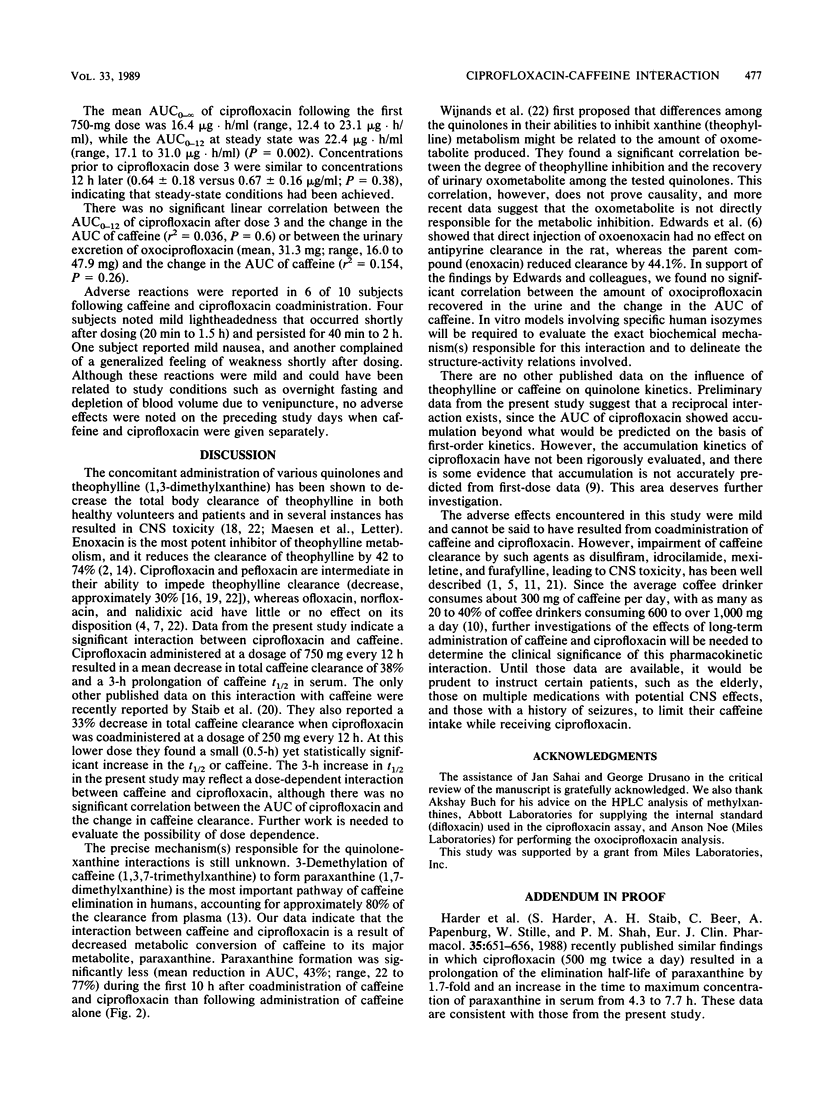
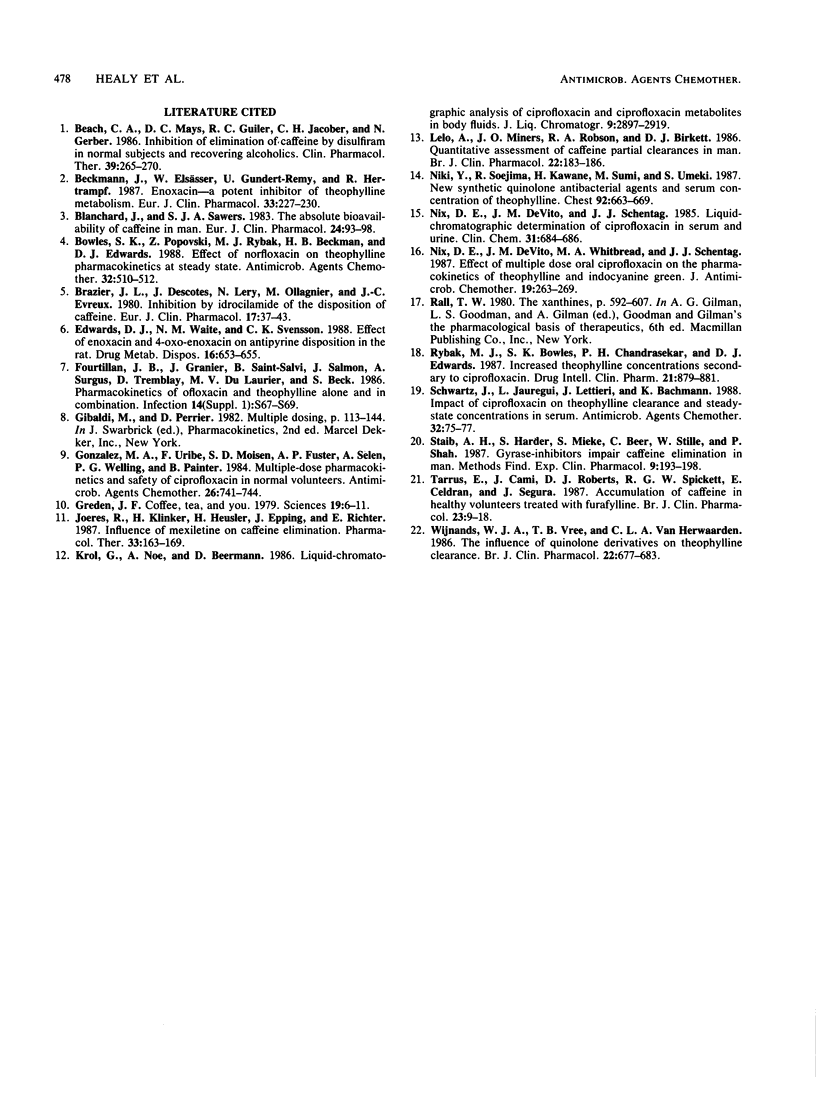
Selected References
These references are in PubMed. This may not be the complete list of references from this article.
- Beach C. A., Mays D. C., Guiler R. C., Jacober C. H., Gerber N. Inhibition of elimination of caffeine by disulfiram in normal subjects and recovering alcoholics. Clin Pharmacol Ther. 1986 Mar;39(3):265–270. doi: 10.1038/clpt.1986.37. [DOI] [PubMed] [Google Scholar]
- Beckmann J., Elsässer W., Gundert-Remy U., Hertrampf R. Enoxacin--a potent inhibitor of theophylline metabolism. Eur J Clin Pharmacol. 1987;33(3):227–230. doi: 10.1007/BF00637553. [DOI] [PubMed] [Google Scholar]
- Blanchard J., Sawers S. J. The absolute bioavailability of caffeine in man. Eur J Clin Pharmacol. 1983;24(1):93–98. doi: 10.1007/BF00613933. [DOI] [PubMed] [Google Scholar]
- Bowles S. K., Popovski Z., Rybak M. J., Beckman H. B., Edwards D. J. Effect of norfloxacin on theophylline pharmacokinetics at steady state. Antimicrob Agents Chemother. 1988 Apr;32(4):510–512. doi: 10.1128/aac.32.4.510. [DOI] [PMC free article] [PubMed] [Google Scholar]
- Brazier J. L., Descotes J., Lery N., Ollagnier M., Evreux J. C. Inhibition by idrocilamide of the disposition of caffeine. Eur J Clin Pharmacol. 1980 Jan;17(1):37–43. doi: 10.1007/BF00561675. [DOI] [PubMed] [Google Scholar]
- Edwards D. J., Waite N. M., Svensson C. K. Effect of enoxacin and 4-oxo-enoxacin on antipyrine disposition in the rat. Drug Metab Dispos. 1988 Jul-Aug;16(4):653–655. [PubMed] [Google Scholar]
- Fourtillan J. B., Granier J., Saint-Salvi B., Salmon J., Surjus A., Tremblay D., Vincent Du Laurier M., Beck S. Pharmacokinetics of ofloxacin and theophylline alone and in combination. Infection. 1986;14 (Suppl 1):S67–S69. doi: 10.1007/BF01645203. [DOI] [PubMed] [Google Scholar]
- Gonzalez M. A., Uribe F., Moisen S. D., Fuster A. P., Selen A., Welling P. G., Painter B. Multiple-dose pharmacokinetics and safety of ciprofloxacin in normal volunteers. Antimicrob Agents Chemother. 1984 Nov;26(5):741–744. doi: 10.1128/aac.26.5.741. [DOI] [PMC free article] [PubMed] [Google Scholar]
- Harder S., Staib A. H., Beer C., Papenburg A., Stille W., Shah P. M. 4-quinolones inhibit biotransformation of caffeine. Eur J Clin Pharmacol. 1988;35(6):651–656. doi: 10.1007/BF00637602. [DOI] [PubMed] [Google Scholar]
- Joeres R., Klinker H., Heusler H., Epping J., Richter E. Influence of mexiletine on caffeine elimination. Pharmacol Ther. 1987;33(1):163–169. doi: 10.1016/0163-7258(87)90046-5. [DOI] [PubMed] [Google Scholar]
- Lelo A., Miners J. O., Robson R. A., Birkett D. J. Quantitative assessment of caffeine partial clearances in man. Br J Clin Pharmacol. 1986 Aug;22(2):183–186. doi: 10.1111/j.1365-2125.1986.tb05247.x. [DOI] [PMC free article] [PubMed] [Google Scholar]
- Niki Y., Soejima R., Kawane H., Sumi M., Umeki S. New synthetic quinolone antibacterial agents and serum concentration of theophylline. Chest. 1987 Oct;92(4):663–669. doi: 10.1378/chest.92.4.663. [DOI] [PubMed] [Google Scholar]
- Nix D. E., De Vito J. M., Schentag J. J. Liquid-chromatographic determination of ciprofloxacin in serum and urine. Clin Chem. 1985 May;31(5):684–686. [PubMed] [Google Scholar]
- Nix D. E., DeVito J. M., Whitbread M. A., Schentag J. J. Effect of multiple dose oral ciprofloxacin on the pharmacokinetics of theophylline and indocyanine green. J Antimicrob Chemother. 1987 Feb;19(2):263–269. doi: 10.1093/jac/19.2.263. [DOI] [PubMed] [Google Scholar]
- Rybak M. J., Bowles S. K., Chandrasekar P. H., Edwards D. J. Increased theophylline concentrations secondary to ciprofloxacin. Drug Intell Clin Pharm. 1987 Nov;21(11):879–881. doi: 10.1177/106002808702101106. [DOI] [PubMed] [Google Scholar]
- Schwartz J., Jauregui L., Lettieri J., Bachmann K. Impact of ciprofloxacin on theophylline clearance and steady-state concentrations in serum. Antimicrob Agents Chemother. 1988 Jan;32(1):75–77. doi: 10.1128/aac.32.1.75. [DOI] [PMC free article] [PubMed] [Google Scholar]
- Staib A. H., Harder S., Mieke S., Beer C., Stille W., Shah P. Gyrase-inhibitors impair caffeine elimination in man. Methods Find Exp Clin Pharmacol. 1987 Mar;9(3):193–198. [PubMed] [Google Scholar]
- Tarrus E., Cami J., Roberts D. J., Spickett R. G., Celdran E., Segura J. Accumulation of caffeine in healthy volunteers treated with furafylline. Br J Clin Pharmacol. 1987 Jan;23(1):9–18. doi: 10.1111/j.1365-2125.1987.tb03003.x. [DOI] [PMC free article] [PubMed] [Google Scholar]
- Wijnands W. J., Vree T. B., van Herwaarden C. L. The influence of quinolone derivatives on theophylline clearance. Br J Clin Pharmacol. 1986 Dec;22(6):677–683. doi: 10.1111/j.1365-2125.1986.tb02957.x. [DOI] [PMC free article] [PubMed] [Google Scholar]


